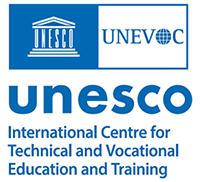
The UNESCO-UNEVOC International Centre: Who We Are | What We Do | Working With Us | Get in Touch
The UNEVOC Network: Learn About the Network | UNEVOC Network Directory
For Members: UNEVOC Centre Dashboard
Thematic Areas: Inclusion and Youth | Digital Transformation | Private Sector Engagement | SDGs and Greening TVET
Our Key Programmes & Projects: BILT: Bridging Innovation and Learning in TVET | Building TVET resilience | TVET Leadership Programme | WYSD: World Youth Skills Day
Past Activities: COVID-19 response | i-hubs project | TVET Global Forums | Virtual Conferences | YEM Knowledge Portal
Our Services & Resources: Publications | TVET Forum | TVET Country Profiles | TVETipedia Glossary | Innovative and Promising Practices | Toolkits for TVET Providers | Entrepreneurial Learning Guide
Events: Major TVET Events | UNEVOC Network News
Digital literacy is the ability to access, manage, understand, integrate, communicate, evaluate and create information safely and appropriately through digital technologies for employment, decent jobs and entrepreneurship. It includes competences that are variously referred to as computer literacy, ICT literacy, information literacy and media literacy.
 Source:
Source:Digital literacy consists of equipping people with ICT concepts, methods and skills to enable them to use and exploit ICTs. The related concept of information literacy consists of providing people with concepts and training in order to process data and transform them into information, knowledge and decisions. It includes methods to search and evaluate information, elements of information culture and its ethical aspects, as well as methodological and ethical aspects for communication in the digital world.
 Source:
Source:Digital literacy should be understood to mean the basic skill or ability to use a computer confidently, safely and effectively, including: the ability to use office software such as word processors, email and presentation software, the ability to create and edit images, audio and video, and the ability to use a web browser and internet search engines. These are the skills that teachers of other subjects at secondary school should be able to assume that their pupils have, as an analogue of being able to read and write.
 Source:
Source:Digital literacy lays out five digital competence areas and a total of 21 digital competencies. The digital competence areas include information and data literacy, communication and collaboration, digital content creation, safety, and problem-solving.
The ability to use the ICT tools required to participate in the workplace, learning institutions, and everyday life. These include the abilities to find, understand, evaluate, create and communicate digital information.
 Source:
Source: Commonwealth of Learning, TVET Professional Development Toolkit for the Pacific, Commonly used terms, n.d.
Commonwealth of Learning, TVET Professional Development Toolkit for the Pacific, Commonly used terms, n.d.